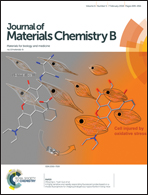Optical glucose sensing using ethanolamine–polyborate complexes†
Abstract
Wound monitoring is essential to tackle chronic complications at their infancy and thus objectively scrutinize any delay in the epithelization process. Since glucose in wound exudates is recognized as key bio-marker in wound monitoring, the development of a cost-efficient detection method for glucose would aid at tackling early-stage infections in wounds. For the first time, we present a novel platform for one-step synthesis of non-enzymatic, cost-efficient optical glucose sensors. These are based on complexes formed by the interactions between polyborates and ethanolamines. The complexes, synthesized by just heating a solution of boric acid and ethanolamines at 150 °C, were characterized using 13C-NMR, 1H-NMR, 11B-NMR, analytical ultracentrifugation and DFT. The results show that the complexes in solution are extremely small (hydrodynamic diameter of around 0.5 nm) and that the polyborates species interact with the ethanolamines via both moderate and weak hydrogen bondings. These complexes were then tested on glucose concentrations ranging from 0 to 10 mM, showing significant changes in the fluorescent emission between the glucose level expressed in an healable wound (5.0–7.6 mM) and a chronic one (0.3–1.0 mM).



 Please wait while we load your content...
Please wait while we load your content...